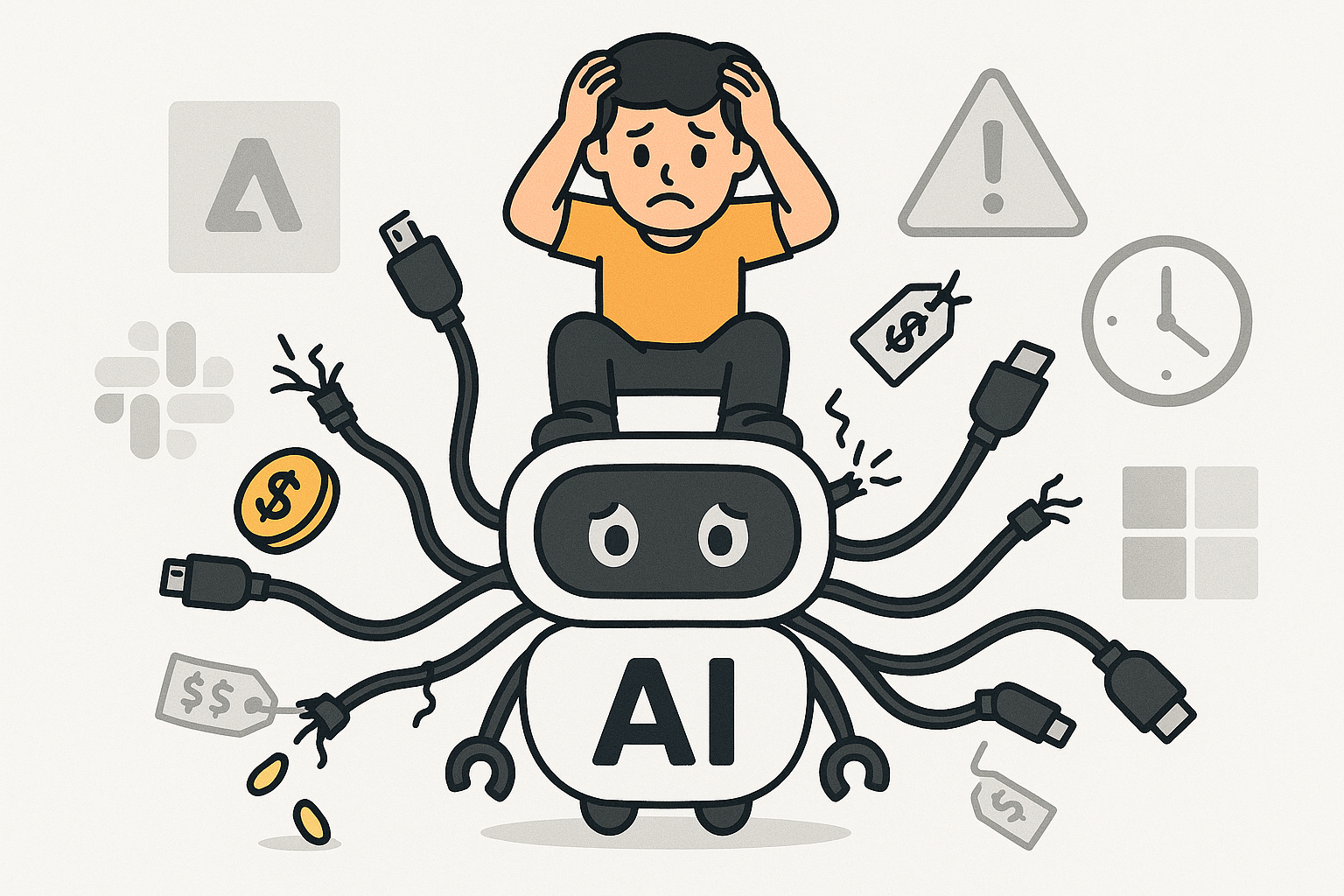The Hidden Costs of Disconnected AI: Why Context Matters in Enterprise
Your organization has invested heavily in AI tools. Employees have access to powerful language models, chatbots handle customer inquiries, and AI assistants promise to revolutionize productivity. Yet despite these investments, many enterprises are discovering a troubling reality: their AI initiatives are delivering far less value than expected, and in some cases, they're actually creating new inefficiencies.

The culprit isn't the AI technology itself—it's the fundamental disconnect between AI tools and the business context where real work happens.
The Productivity Paradox: When AI Makes Work Harder
Consider Sarah, a sales manager at a mid-sized software company. She uses an AI assistant to help draft client proposals, but the process looks like this:
- Ask AI to draft a proposal template
- Switch to the CRM to look up client history and preferences
- Return to AI to refine the proposal with client-specific details
- Check inventory systems to verify product availability
- Go back to AI to adjust pricing and delivery timelines
- Open the project management tool to check team capacity
- Return to AI one final time to incorporate resource constraints
What should be a 15-minute task becomes an hour-long exercise in application juggling. The AI assistant, despite its sophisticated language capabilities, operates in complete isolation from the business systems that contain the critical context needed to do the job effectively.
This scenario plays out thousands of times daily across enterprises, creating what we call "context switching overhead"—the hidden productivity tax of disconnected AI.
The Real Cost of Context Switching
Research from productivity studies shows that each context switch between applications costs an average of 23 minutes for workers to fully refocus. In AI-augmented workflows, employees often switch contexts 3-5 times per task as they manually ferry information between their AI tools and business systems.
For a 500-person organization where employees use AI for just 2 hours daily, context switching overhead can cost over 1,900 hours of productivity each week. At average employee costs, this represents millions in lost productivity annually—often exceeding the entire AI technology budget.
Data Silos: The Information Fortress That AI Can't Breach
Most enterprise AI implementations suffer from what information architects call "the fortress problem." Your most valuable business intelligence is locked away in specialized systems:
- Customer insights trapped in CRM platforms
- Financial data isolated in ERP systems
- Project status buried in management tools
- Market intelligence scattered across databases
- Operational metrics confined to monitoring dashboards
Generic AI assistants can't access these information fortresses, forcing them to operate with incomplete, outdated, or irrelevant context. The result is AI that provides generic advice when employees need specific, actionable guidance based on current business reality.
The Frustration Factor: When AI Becomes Another Tool to Manage
Perhaps the most overlooked cost of disconnected AI is employee frustration and eventual abandonment. Initial enthusiasm for AI tools quickly wanes when employees realize that:
- AI responses require extensive fact-checking against business systems
- Simple requests require complex prompt engineering to be useful
- The AI can't learn from or remember important business context
- Tasks still require manual work across multiple systems
This frustration manifests in two costly ways: employees either abandon AI tools entirely (wasting the investment) or spend excessive time trying to make disconnected AI work (reducing overall productivity).
The Customer Experience Disconnect
The impact extends beyond internal operations. Customer-facing AI systems without business context create service gaps that damage relationships:
A customer service AI that can't access order history provides generic responses to specific problems. A sales AI that doesn't know inventory levels makes promises the company can't keep. A support AI without access to technical documentation provides outdated troubleshooting steps.
Each disconnect erodes customer trust and forces human intervention, defeating the purpose of AI automation.
The Compliance and Risk Challenge
Disconnected AI creates significant governance challenges. When AI systems operate without access to current business data, they can:
- Provide advice that violates current compliance requirements
- Make recommendations based on outdated policies
- Generate content that conflicts with approved messaging
- Create documentation that doesn't reflect actual procedures
The risk mitigation efforts required to manage disconnected AI often consume more resources than the AI saves.
The Innovation Bottleneck
Perhaps most critically, disconnected AI prevents organizations from realizing AI's transformative potential. Instead of augmenting human decision-making with comprehensive business intelligence, disconnected AI relegates artificial intelligence to basic text generation and generic assistance.
This limitation creates an innovation bottleneck where AI initiatives plateau at simple automation rather than evolving into strategic business intelligence capabilities.
The Path Forward: Connected AI as Strategic Advantage
The organizations that will win with AI aren't necessarily those with the most advanced models—they're the ones that successfully connect their AI capabilities with their business context. Connected AI systems that understand your customers, know your inventory, access your project status, and work within your compliance framework don't just eliminate the hidden costs of disconnected AI—they create compounding productivity gains.
When AI assistants have real-time access to business systems, context switching disappears, data silos become irrelevant, and employee frustration transforms into genuine productivity enhancement. More importantly, connected AI enables new categories of business value that simply aren't possible with isolated tools.
Calculating Your Disconnected AI Tax
To understand your organization's disconnected AI costs, consider:
- How many hours per week do employees spend switching between AI tools and business systems?
- What percentage of AI-generated content requires manual verification against business data?
- How often do AI recommendations conflict with current business constraints or policies?
- What customer service issues stem from AI systems lacking business context?
The answers often reveal that the hidden costs of disconnected AI far exceed the obvious benefits, making the case for connected AI solutions not just compelling, but financially urgent.
Ready to eliminate the hidden costs of disconnected AI in your organization? Discover how connected AI solutions can transform your productivity, reduce operational overhead, and unlock the full potential of your AI investments.
